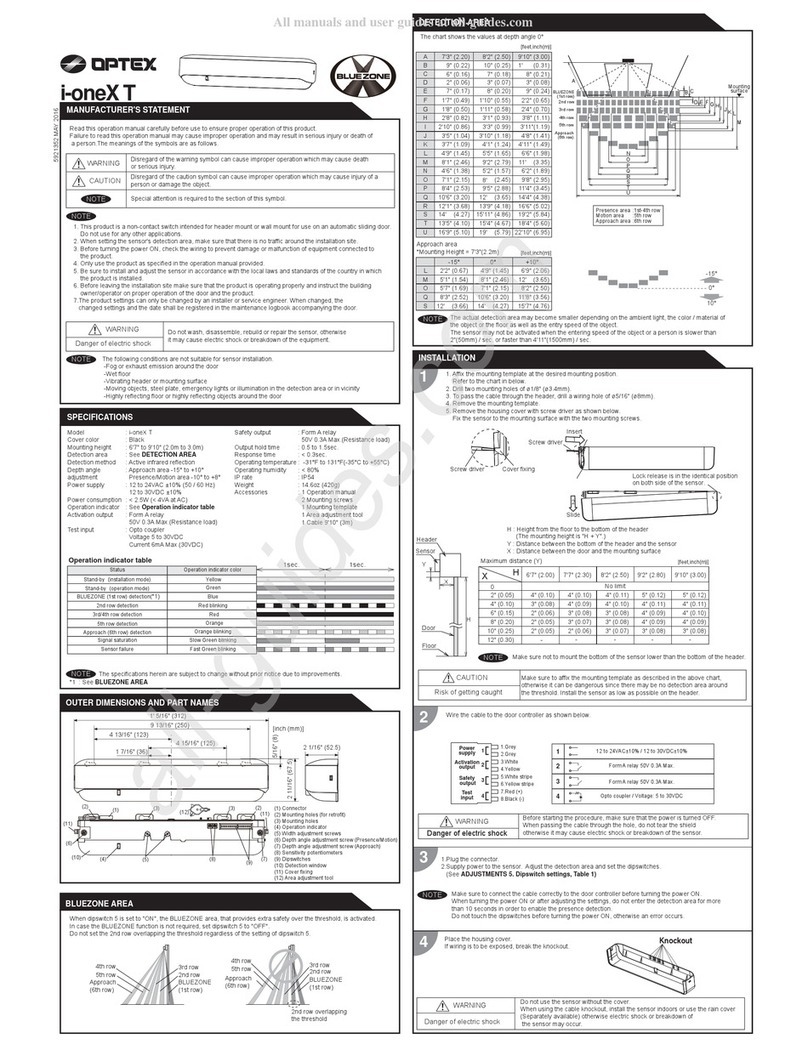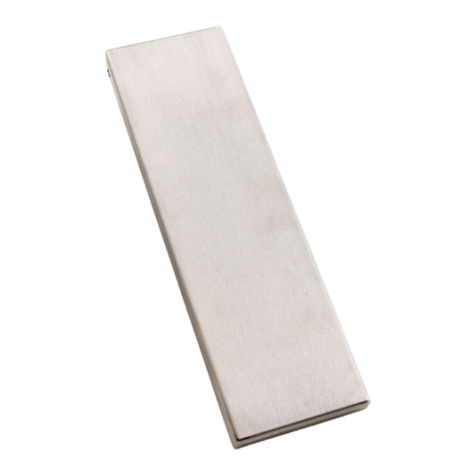Narrow lens
After changing the dipswitch settings, make sure to push the function
switch for 2 seconds.
2
1
ADJUSTMENTS
Red
Area depth angle adjustment Area adjustment tool
A
B
Area width adjustment
Blue
Depth angle adjustment screw
for the AIR area Depth angle adjustment screw
for the microwave area
Use the area adjustment tool (A) as shown above
to change the area depth angle.
For the easier adjustment, see REFERENCE.
3
1-1AIR adjustment
2-1 AIR adjustment
1-2 Microwave adjustment
Depth angle
adjustment screw
Shallow Deep
Check the operation in the operation mode according to the chart below.
Dipswitch settings
When adjusting the 2nd row close to the door,
follow Table 2 dipswitch16 for the easier adjustment.
1. Always keep the detection window clean. If dirty, wipe the window with a damp cloth. Do not use any cleaner / solvent.
2. Do not wash the sensor with water.
3. Do not disassemble, rebuild or repair the sensor yourself, otherwise an electric shock may occur.
4. When the operation indicator blinks green, contact your installer or service engineer.
5. Always contact your installer or service engineer when changing the settings.
6. Do not paint the detection window.
WARNING
1. When turning the power ON, always walk-test the detection area to ensure the proper operation.
2. Do not place any objects that move or emit light in the detection area. (e.g. plant, illumination, etc.)
Make sure that the detection area does not overlap with the door / header, and there is no highly reflecting
object near the detection area otherwise ghosting / signal saturation may occur.
NOTE
NOTE
NOTE
4
CHECKING
INFORM BUILDING OWNER / OPERATOR OF THE FOLLOWING ITEMS
Make sure to confirm the following content to comply with EN16005.
1. Detection area settings (See DETECTION AREA )
2. Presence timer (See ADJUSTMENTS 4. Dipswitch settings )
3. Self monitoring (See ADJUSTMENTS 4. Dipswitch settings )
TO COMPLY WITH EN16005
Shallow Deep
When setting the detection area width, make sure to turn
the adjustment screws until it clicks.
cannot be eliminated separately, neither can
1 2 3 10 11 12
Width adjustment screws
Narrow
Wide
Eliminated
Eliminated Eliminated
Eliminated
1 2 3 10 11 12
OPTEX Co.,LTD.
Manufacturer
5-8-12 Ogoto Otsu 520-0101, Japan
TEL.: +81(0)77 579 8700 FAX.: +81(0)77 579 7030
WEBSITE: www.optex.co.jp/as/eng/index.html
OPTEX Technologies B.V.
European Subsidiary
Tiber 2, 2491 DH The Hague, The Netherlands
TEL.: +31(0)70 419 41 00 FAX.: +31(0)70 317 73 21
To adjust the AIR detection area width, use the
adjustment screws as shown in the picture below.
2-2 Microwave adjustment
Use the area adjustment tool (B) as shown above
to change the area depth angle.
To adjust the microwave detection area width, use the
narrow lens as shown in the picture below.
push 2 seconds
2.Open
2.Open 1.Remove screw
L H
H
L
02000
(6′6")
3000
(9′10")
3000
(9′10")
1000
(3′3")
2000
(6′6")
1000
(3′3")
2000
(6′6")
1000
(3′3")
3000
(9′10")
0
Top view
H
L
[mm(feet,inch)]
Mounting height : 2.2m (7'2")
Vertical adjustment : +35°
Wide area
Narrow area
Status
Green
Motion
detection active
Red
Red blinking
Blue
Entry Outside of
detection
area
Entry into
microwave area
Entry into
3rd row
Entry into
2nd row
Entry into
Lookback
(1st row)
Orange
Stand-by
Operation indicator
Motion / Presence
detection active
Power OFF
-
None
Activation
output
Safety
/ Test
output
ON OFFOFF
OFF ONOFF
High
7
Low
7
N.O.
12
Safety
13
N.C.
12
N.O.
12
N.C.
12
Safety
+
Activation
13
OAM-
DUAL T/TT
OAM-
DUAL TV
OAM-
DUAL TF
Safety
13
Safety + Activation
13
Safety
13
Safety + Activation
13
0V *
*
*
0V
<=0.5V
<=0.5V <=0.5V
0Hz 100Hz 100Hz
100Hz
0Hz
0Hz
0Hz 0Hz
*After changing the dipswitches and/or potentiometer settings, make sure to push the function switch for
2 seconds.
AIR settings Microwave settings Other settings
Contact your installer or service engineer.
Sensor failure
Wrong wiring or connection failure. Check the wires and connector.
Wrong wiring or connection failure. Check the wires and connector.
Door operation Operation
indicator Possible cause Possible countermeasures
None Wrong power supply voltage. Set to the stated voltage.
Wrong wiring or connection failure.
Fast
green
blinking
Signal saturation (2nd or 3rd row)
Dirty detection window Wipe the detection window with a damp cloth.
Do not use any cleaner or solvent.
Sensitivity is too low. Set the sensitivity higher.*
Set AIR area width to "wide".
The detection area overlaps with
the door / header.
Adjust the detection area to "deep". (outside)
Door opens
when no one
is in the
detection area.
(ghosting)
Unstable
Door remains
open Sudden change in the detection area Check Table 2 dipswitch 1 to 4*
If the problem still persists, hard-reset the
sensor.(Turn the power OFF and ON again)
Slow
green
blinking
Check the wires and connector.
Remove highly reflecting objects from the
detection area. Lower the sensitivity.*
Change the area depth angle for AIR area.
Remove highly reflecting objects from the
detection area. Lower the sensitivity.*
Change the area depth angle for AIR area.
Setting error of dipswitch and/or
potentiometer
Red &
green
blinking
Door does not
open when a
person enters
the detection
area.
Unstable Wrong detection area positioning. Check ADJUSTMENTS 1, 2 ,3 & 4.*
Sensitivity is too low. Set the sensitivity higher.*
Short presence timer. Set the presence timer longer.*
Proper
Proper
Setting error of dipswitches Check Table 2 dipswitch 7, 8, 12, 14.*
Dirty detection window. Wipe the detection window with a damp cloth.
Do not use any cleaner or solvent.
TROUBLESHOOTING
REFERENCE
After changing the dipswitches and/or
potentiometer settings, make sure to push the
function switch for 2 seconds.
Proper
operation
Others Set
dipswitch 11 to ON.
*
Waterdrops on the detection window.
The detection area overlaps with
another sensor.
Detection area overlaps with door /
header.
Check Table 2 dipswitch 5, 6.*
Objects that move or
emit light in the detection area.
Remove the objects.
Sensitivity is too high. Set the sensitivity lower.*
Installation mode is set to ON. Set dipswitch 16 to OFF.*
Yellow
Signal saturation (Lookback)
Slow
green
blinking
Set dipswitch 9 and / or dipswitch 11 to ON.*Raining or snowing
Table 2
Adjust the microwave detection area with potentiometer.
Afterwards, make sure to push the function switch for
2 seconds.
ShallowDeep
*3.2V@10mA Min.4.5V(no load)
INFRARED FINDER
Detection area
Detection area
1. Turn the depth angle adjustment screw to the right (deep) to place the detection area most away from the door.
2. Set INFRARED FINDER sensitivity to "H" (high) and place it on the floor as shown below.
Area depth adjustment with INFRARED FINDER (separately available)
3. Turn the depth angle adjustment screw to the left (shallow) until the emitting area is placed at the position where
INFRARED FINDER is in the low detection status (slow red blinking).
Wipe the detection window with a damp cloth.
Do not use any cleaner or solvent.
To comply with EN16005, set the timer to
"30sec."or more.To enable the presence
detection, do not enter the detection area
for 10 seconds after setting the timer.
When using more than two sensors close
to each other, set the frequency different
for each sensor.
The delay time between test input and
Safety / Test output is 10msec.
When dipswitch 9 is set to uni-directional,
this setting enables the door to close
earlier when a person walks away from
the door.
When dipswitch 10 is set to ON, a person
wavering in the motion detection area can
be detected. This is only effective when
dipswitch 9 is set to uni-directional.
Set dipswitch 9 to ON when the sensor
operates by itself (ghosting).
When dipswitch 11 is set to ON the actual
detection area may occur smaller.
Select N.O/N.C for the activation output
(OAM-DUAL T only)
Select N.O/N.C for the activation /
Testoutput.
(OAM-DUAL TT only)
When dipswitch 13 is ON, the sensor
outputs safety and activation simultane-
ously.
When the door remains open and the
operation indicator shows fast / slow green
blinking, refer to TROUBLESHOOTING.
If the door still remains open, set dipswitch
14 to "Disable".To comply with EN16005,
set the self monitoring to "Enable".
When dipswitch 15 is set to ON, the
lookback (1st row) is active and looks
through the threshold.
Set dipswitch 16 to ON to adjust the 2nd
row. After setting the row switch dipswitch
16 OFF. During the installation mode only
the 2nd row remains active and the
operation indicator shows yellow.
Presence timer
Frequency
43 43 43 43
600sec
180sec
60sec
30sec
65 65 65 65
Setting1 Setting4
Setting3
Setting2
Test input
(from the door controller)
High Low
High Low
Bi Uni
OFF ON
OFF ON
Safety / Testoutput
(to the door controller)
Direction
Autocaution
Immunity
N.O. N.C.
Activation output
Activation / Testoutput
(to the door controller)
Safety Safety +
Activation
AIR output
Enable Disable
Self monitoring
OFF ON
Lookback
OFF ON
Installation mode
7
8 8
9 9
10 10
11 11
12 12
N.O. N.C.
12 12
13 13
14 14
15 15
16 16
7
Function
Dipswitch
1
Dipswitch
2
Dipswitch
3
Dipswitch
4
Dipswitch
5
Dipswitch
6
Dipswitch
7
Dipswitch
8
Dipswitch
9
Dipswitch
10
Dipswitch
11
Dipswitch
12
Dipswitch
13
Dipswitch
14
Dipswitch
15
Dipswitch
16
Set the sensitivity according to the
mounting height. Values below dipswitch
are reference only. Adjust the sensitivity
according to your risk assessment.
Setting
21 21 21 21
Low Middle High S-High
Sensitivity
Comment
2.0 to 3.0m 2.0 to 3.0m 2.5 to 3.2m 3.0 to 3.5m
Microwave sensitivity
Adjust the detection area to "deep" (outside).
Or set dipswitch 11 to ON.
*
ShallowDeep
2000
(6′6")
3000
(9′10")
2000
(6′6")
3000
(9′10")
2000
(6′6") 1000
(3′3")
2000
(6′6") 1000
(3′3")
00
00
[mm(feet,inch)] [mm(feet,inch)]
Front view
[mm(feet,inch)]
0
0
1 2 3 4 5 6 7 89 10 11 12
2000
(6′6")
2000
(6′6")
1000
(3′3")
1000
(3′3")
3000
(9′10")
2000
(6′6")























